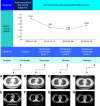Lung cancer with concurrent EGFR mutation and ROS1 rearrangement: a case report and review of the literature
- PMID: 27486332
- PMCID: PMC4956058
- DOI: 10.2147/OTT.S109415
Lung cancer with concurrent EGFR mutation and ROS1 rearrangement: a case report and review of the literature
Abstract
ROS1 rearrangement has recently emerged as a new molecular subtype in non-small cell lung cancer, and is predominantly found in lung adenocarcinomas compared with other oncogenes such as EGFR, KRAS, or ALK. Patients who have both mutations are extremely rare. Here we report a 50-year-old female diagnosed with adenocarcinoma with sarcomatoid differentiation, who was shown to have EGFR and ROS1 mutations. The patient was treated surgically and received three cycles of adjuvant postoperative chemotherapy. In addition, we reviewed the previously reported cases and related literature. This presentation will provide further understanding of the underlying molecular biology and optimal treatment for non-small cell lung cancer patients with more than one driver mutation.
Keywords: EGFR gene mutation; ROS1 fusion gene; non-small cell lung cancer.
Figures



Similar articles
-
Concurrent ROS1 gene rearrangement and KRAS mutation in lung adenocarcinoma: A case report and literature review.Thorac Cancer. 2018 Jan;9(1):159-163. doi: 10.1111/1759-7714.12518. Epub 2017 Oct 3. Thorac Cancer. 2018. PMID: 28971587 Free PMC article.
-
Lung adenocarcinoma with concurrent ALK and ROS1 rearrangement: A case report and review of the literatures.Pathol Res Pract. 2018 Dec;214(12):2103-2105. doi: 10.1016/j.prp.2018.09.028. Epub 2018 Oct 1. Pathol Res Pract. 2018. PMID: 30327151 Review.
-
Clinicopathological characteristics and outcomes of ROS1-rearranged patients with lung adenocarcinoma without EGFR, KRAS mutations and ALK rearrangements.Thorac Cancer. 2015 Jul;6(4):413-20. doi: 10.1111/1759-7714.12191. Epub 2015 Jul 2. Thorac Cancer. 2015. PMID: 26273395 Free PMC article.
-
Efficacy of Pemetrexed-Based Chemotherapy in Patients with ROS1 Fusion-Positive Lung Adenocarcinoma Compared with in Patients Harboring Other Driver Mutations in East Asian Populations.J Thorac Oncol. 2016 Jul;11(7):1140-52. doi: 10.1016/j.jtho.2016.03.022. Epub 2016 Apr 16. J Thorac Oncol. 2016. PMID: 27094798
-
Management of advanced non-small cell lung cancers with known mutations or rearrangements: latest evidence and treatment approaches.Ther Adv Respir Dis. 2016 Apr;10(2):113-29. doi: 10.1177/1753465815617871. Epub 2015 Nov 30. Ther Adv Respir Dis. 2016. PMID: 26620497 Free PMC article. Review.
Cited by
-
Syndecan 4-c-ros oncogene 1 fusion as a mechanism of acquired resistance in epidermal growth factor receptor mutant lung adenocarcinoma.Chin Med J (Engl). 2019 Dec 20;132(24):3015-3017. doi: 10.1097/CM9.0000000000000555. Chin Med J (Engl). 2019. PMID: 31809319 Free PMC article. No abstract available.
-
[A Case Report of Coexistence of EGFR and ROS-1 Gene Mutations in Non-small Cell Lung Cancer].Zhongguo Fei Ai Za Zhi. 2025 Jun 20;28(6):482-486. doi: 10.3779/j.issn.1009-3419.2025.102.26. Zhongguo Fei Ai Za Zhi. 2025. PMID: 40640100 Free PMC article. Chinese.
-
ROS-1 Fusions in Non-Small-Cell Lung Cancer: Evidence to Date.Curr Oncol. 2022 Jan 28;29(2):641-658. doi: 10.3390/curroncol29020057. Curr Oncol. 2022. PMID: 35200557 Free PMC article. Review.
-
Transcriptomic analyses of differentially expressed human genes, micro RNAs and long-non-coding RNAs in severe, symptomatic and asymptomatic malaria infection.Sci Rep. 2024 Jul 23;14(1):16901. doi: 10.1038/s41598-024-67663-w. Sci Rep. 2024. PMID: 39043812 Free PMC article.
-
A novel co-existing ZCCHC8-ROS1 and de-novo MET amplification dual driver in advanced lung adenocarcinoma with a good response to crizotinib.Cancer Biol Ther. 2018;19(12):1097-1101. doi: 10.1080/15384047.2018.1491506. Epub 2018 Aug 10. Cancer Biol Ther. 2018. PMID: 30095326 Free PMC article.
References
-
- Kim HR, Lim SM, Kim HJ, et al. The frequency and impact of ROS1 rearrangement on clinical outcomes in never smokers with lung adenocarcinoma. Ann Oncol. 2013;24(9):2364–2370. - PubMed
-
- Mescam-Mancini L, Lantuéjoul S, Moro-Sibilot D, et al. On the relevance of a testing algorithm for the detection of ROS1-rearranged lung adenocarcinomas. Lung Cancer. 2014;83(2):168–173. - PubMed
Publication types
LinkOut - more resources
Full Text Sources
Other Literature Sources
Research Materials
Miscellaneous

